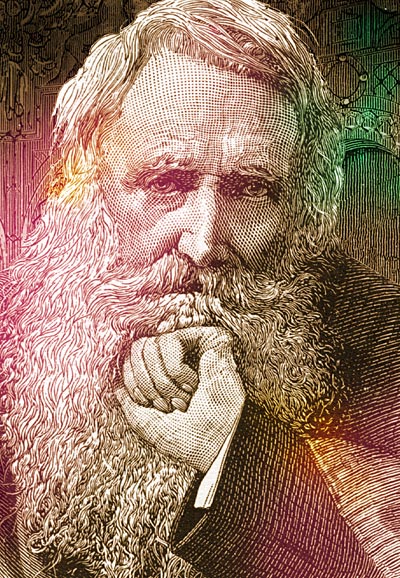SAMUEL & CONSTANCE
The Church of Spiritual Commerce
"Life is an exchange," Samuel Brundt was wont to say. "An exchange of heat, energy, force, love, hate, art. There are spiritual and material transactions occurring every minute. Our monetary system is a microcosm of this." (Excerpt from, The Great Transaction, by Samuel Brundt, New York 1843) The Church of Spiritual Commerce grew out of the philosophy and teachings of Samuel and Constance Brundt. It officially formed in New York City on January 1, 1838 as a metaphysical society of like-minded thinkers, and had an initial membership of 16 people.
Samuel Brundt was a prolific pamphleteer and author, writing many small books, tracts, and pamphlets, which he distributed in America and around the world. His philosophical and theological views were hotly debated in the academic circles of America at the time. Many believed him to be a crackpot, but some believed he had discovered a valuable new way of looking at the world. He believed in the phrase, "as above, so below." And as such, he felt that many earthly or material patterns reflected spiritual patterns, and universal human constructs also reflected universal truths. Therefore, monetary systems represented a human reconstruction of the functioning of the universe. Where a barter |

|
system might crudely represent a physical exchange of forces, a monetary system represented the more evolved or abstract idea of energy. It is energy that lies beneath physical exchanges of force, so the concept of a monetary system represents the abstract forces behind social interaction. This idea, together with all its implications, became one of the central concepts in his new cosmology.
The concept of "spiritual transactions" led to a unique view of the role a church member must take within the community. Since all members of the church engaged in "spiritual transactions," it follows that as well as receiving teachings and spiritual insights from the church, all members must equally contribute teachings and insights to the community in return. Also, the Brundt's actively sought out the best and the brightest from the literary, artistic, and scientific communities for their members. This resulted in an unprecedented torrent of intellectual and creative activity within the Colony. Every member was extremely active in creating art, philosophy, and writings and continually published and distributed their work within Nadiria. This is the main reason why Samuel Brundt ensured that a printing press and several engravers and typesetters were among the first of the arrivals at the Colony.
Constance Brundt was the Dream Prophetess of the Church. She had a unique ability to see beyond the temporal veil with her dreams, and she gave guidance and revelations to the church with them. Her gift, she believed, was a direct connection to God - a tap into the Great Source of Life and Being. She studied many different dream techniques, those of the Egyptians, Indians, and traditions gathered from the South Seas. Urged by her husband Samuel, Constance experimented with using his natural number system to generate dreams. This proved so fruitful, that she developed an entire system for "dream-seeding" using his natural numbers. Eventually, this evolved into the creation and use of Dream-Dollars for use in dream seeding. Constance designed the visual content and iconography of the famous Dream-Dollars, while Samuel created the numerological system on which it was based.
Together they devised the plan to use Dream-Dollars as a form of social engineering. By having the whole colony abandon a standard number system and adopt a more irrational, "natural" number system, the Brundt's hoped to bring about a change in the way the colonists thought and imagined. They believed that constructs such as language and mathematics shape the mind and determine the way we think and create. By radically changing something as basic as the number system people use, Samuel Brundt believed he could radically change the human thought process, to evolve it into a higher, more perfect process. The number system is elucidated in several of his writings, most notably in his tract, The Wheel of Light (New York, 1845). Samuel Brundt felt that because of the strong effects Dream-Dollars had on dreaming, they would have a tremendous impact on the subconscious minds of the spenders of the his money. |